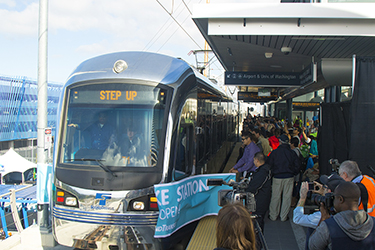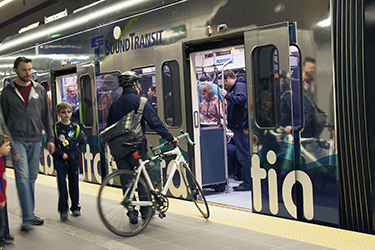|
Subscribe / Renew |
|
|
Contact Us |
|
| ► Subscribe to our Free Weekly Newsletter | |
| home | Welcome, sign in or click here to subscribe. | login |
Architecture & Engineering
| |

|
|
Design Perspectives By Clair Enlow |
November 2, 2016
Design Perspectives: ST3: Even at $54B, it's the only way to grow
Special to the Journal
You don't really believe that stuff about light rail relieving traffic congestion, do you? Good, because in case you haven't already noticed, it won't.
Vote for ST3 (Proposition 1) anyway. You could say it takes potential cars off of imaginary future highway lanes, ones that can never actually be built, because there's no room for more lanes around here.
But the truth is really simpler than that. Light rail is not for the relief of drivers, present or future. It's for the future of the city. It happens to be the best solution to the problem of how to move people around in an urban environment. Ours is not the first region with that problem, but it's a good one to have.
It's even better if it's solved before traffic chokes the area to a standstill.
We know it works, because we now have some experience to go by. Those of us who ride light rail in Seattle have seen demand grow over the past seven years — slowly at first, but surely. Suburban cities are clamoring to get on board.
ST3 will yield 62 new miles and connect the urban areas of three counties. Riders will be able to travel easily and predictably from Tacoma to Everett, and east to Redmond and Issaquah.
Still it's a staggering price: $54 billion. The package includes other forms of transit, including bus rapid transit and commuter rail, but light rail is at the heart of it, and it's ultimately expected to serve 600,000 riders a day.
The value is much greater than the cost. And the cost is likely to stand the test of time. If Sound Transit has learned anything about megaprojects, it's this: Estimate high. Bring it in lower. The public will love it, and support for the agency will grow. They're counting on it.
Calculating the cost
After literally decades of debate, our region voted yes on light rail in 1996 with Sound Move. That ballot measure only began to fund the first leg of the system, from downtown to SeaTac, which opened in 2009. In the 1990s, Sound Transit lived through a political and organizational crisis as costs exploded long before trains were running.
Then, after 2001, Sound Transit got good at delivering on time and under budget. The agency's reputation rose like a star student. Two decades after that first vote it's still rising. But it's difficult to get your mind around the cost of ST3. How exactly do you get to a real price for building out a 116-mile light rail network over the next two decades?
The short answer is, you don't. As it goes to the vote, the design of the system is at about five percent completion. While that low percent is pretty much inevitable, it leaves a lot of uncertainty, according to John Howell of Cedar River Group. He served as administrator for a special panel assembled by the state to review the ST3 package and costs. “One of the very hard lessons learned about Sound Move was that (cost) was underestimated,” said Howell.
Sound Transit used actual experience from completed segments of the last big push for adding stations, ST2, as the building blocks for estimating ST3. The agency built a kind of table based on 10 different construction categories, from station sites and right-of-way to guideways and vehicles. Each segment of the new system was compared with similar segments already built in ST2. Still, because of the early stage of design there's a hefty contingency buffer built in — 20 to 30 percent, according to Howell.
An army of auditors has studied the revenue sources that cover the cost. But any way you look at it, the price is still staggering. Tri-county taxpayers will be borrowing against future growth to fund ST3.
Gross urban product
So even though we don't know exactly how much it will cost or what all the benefits are, the reasons to invest are pretty compelling. Here are some highlights:
• People will want to ride. Studies have shown that rail attracts new riders to mass transit in a way that buses simply do not. In other words, people who might not otherwise leave their cars will change their lives for trains. The main intuitive reasons include convenience. Just find a station and wait up to 10 minutes. Then there's predictability — trains don't get stuck in traffic.
• Capacity can't be added any other way. A freeway lane can move 2,000 cars per hour, tops. Light rail can move up to eight times that many, depending on frequency and number of cars. If the guideway is independent of the road, that's all new capacity, unlike bus lanes. But even if a freeway lane is given over to rail, it's an enormous net gain when it comes to moving people — not vehicles.
• It will raise the gross urban product. This hypothetical measure would include not just goods and services in the region, but savings to individual households. Transit planners are fond of citing the fact that transportation is the second largest household expense, after rent, for Americans — most of whom depend on cars to get around.
Consider the cumulative savings to households convenient to light rail. Then there's the appreciation in value for real estate close to transit stations and planned transit stations, estimated at 10 percent in many places. Employers are attracted to transit, and to cities that have robust systems. In the Seattle area, large employers — from Amazon to REI to Weyerhaeuser — have made decisions to locate near light rail. Employers can more easily retain workers when they have easy access to rail. Experts have calculated an economic multiplier effect for dollars spent on transit infrastructure: three to four dollars of growth for each dollar spent. The Washington State Office of Financial Management has calculated that ST3 will support 144,000 jobs in the area, not counting the 78,000 jobs involved in building out the system over 25 years.
• Finally, it will help save the earth. Light rail trips may not relieve congestion, but many riders would likely be burning fossil fuel to get where they need to go if they weren't able to ride. It's good for air quality. The larger benefit is in compact, pedestrian-friendly development that light rail stations support and encourage, especially in growing urban areas like ours. This alone saves greenhouse gas emissions and lots of electricity on homes that would otherwise be built in sprawling developments. The benefits are on a planetary scale.
Last year the region grew by about 52,000 people — that's 1,000 new residents every week — and 800,000 more new residents are expected by 2040. With ST3, light rail could carry 600,000 of them per day.
The train has already left the station. But get on board, anyway. It's the only way to grow.
Clair Enlow can be reached by e-mail at clair@clairenlow.com.
Previous columns:
- Design Perspectives: A path of great resistance in Steinbrueck Park, 10-12-2016
- Design Perspectives: Townhouses adding density to neighborhoods, 09-14-2016
- Design Perspectives: The future looks bright for Seattle's waterfront, 08-10-2016
- Design Perspectives: Occidental Park getting a great new neighbor, 07-27-2016
- Design Perspectives: Can we put a lid over our urban freeways?, 06-29-2016
- Design Perspectives -- District energy: Lots of talk, but still little action, 06-08-2016
- Design Perspectives: New paths and parks make Yesler Terrace shine, 05-04-2016
- Design Perspectives: Cities improving streets with paint, and political will, 04-06-2016




